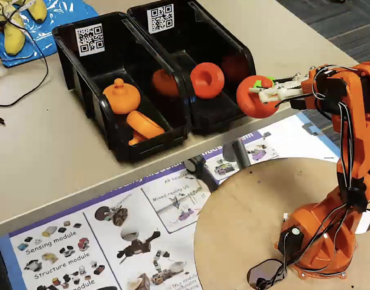Manufacturing Effort Focuses on Human-Machine Interface

Source: Purdue University
The rush to automate manufacturing has revealed some unintended consequences as market pressures and assembly line realities underscore the fact that, sometimes, machines simply cannot replace humans when making things.
That reality was highlighted earlier this year when electric car maker Tesla was forced to replace robots with humans when bottlenecks backed up car production. Tesla managers literally tore out expensive robotics and hired up to 400 new workers a week to handle tasks his bulky robotic arms could not, like bolting seats to Tesla Model 3 chassis.
In another example, human operators replaced robots in the Tesla Model 3 paint booths after the automated system was releasing new vehicles a few seconds before paint jobs were completed. According to an account in the New York Times, the company had human operators monitor the paint booths. These on-the-fly fixes amounted to an admission by Tesla that the fine-tuning of its automated assembly line presents ongoing challenges.
The critical interface between human and robots on the assembly line is the focus of a university research effort aimed at allowing manufacturers to simulate the interactions among workers, robots and machines. The initiative is part of federal effort to envision the factory floor of the future.
The National Science Foundation (NSF) is funding the manufacturing effort through a $2.5 million grant shared by researchers at Indiana University, MIT and project leader Purdue University. The researchers said simulations cloud span everything from an entire factory to a specific workflow. The simulation platform will use AI tools, augmented reality to help robots perceive objects as well as Internet of Things (IoT) networks to link machines to robots and human operators.
Simulations include instructing workers on how to program a robot to perform a specific task. That training could eventually be used program machines to take over routine tasks while workers learn to share more complex tasks with robots. Ultimately, the combination would boost productivity without replacing workers.
"Augmented reality and the Internet of Things would allow robots to extend the mind and hands of a worker, so workers could do much more challenging tasks that robots cannot do," said Karthik Ramani, project leader and a Purdue professor of mechanical engineering.
The manufacturing initiative also will tackle the manufacturing skills gap as workers fall behind in the ability to operate, for example, numerical control machinery, or calibrate robots for high-volume production. “The hope is that a new generation of technologies, powered by artificial intelligence and augmented reality, can both generate greater productivity growth and complement rather than replace workers," said Daron Acemoglu, an MIT economic professor.
To that end, the NSF effort also focuses on worker training in areas like programming that could be applied to design and prototyping efforts. Those skills would have proven useful for car maker Tesla as it struggled to calibrate its fully automated assembly line to ramp up Model 3 production.
Ultimately, the university research effort seeks to leverage emerging industrial IoT and machine learning tools to make the “smart factory” a reality. “The idea is to create and serve future manufacturing, rather than just trying to fix problems in the present," Ramani said.
Related
George Leopold has written about science and technology for more than 30 years, focusing on electronics and aerospace technology. He previously served as executive editor of Electronic Engineering Times. Leopold is the author of "Calculated Risk: The Supersonic Life and Times of Gus Grissom" (Purdue University Press, 2016).










